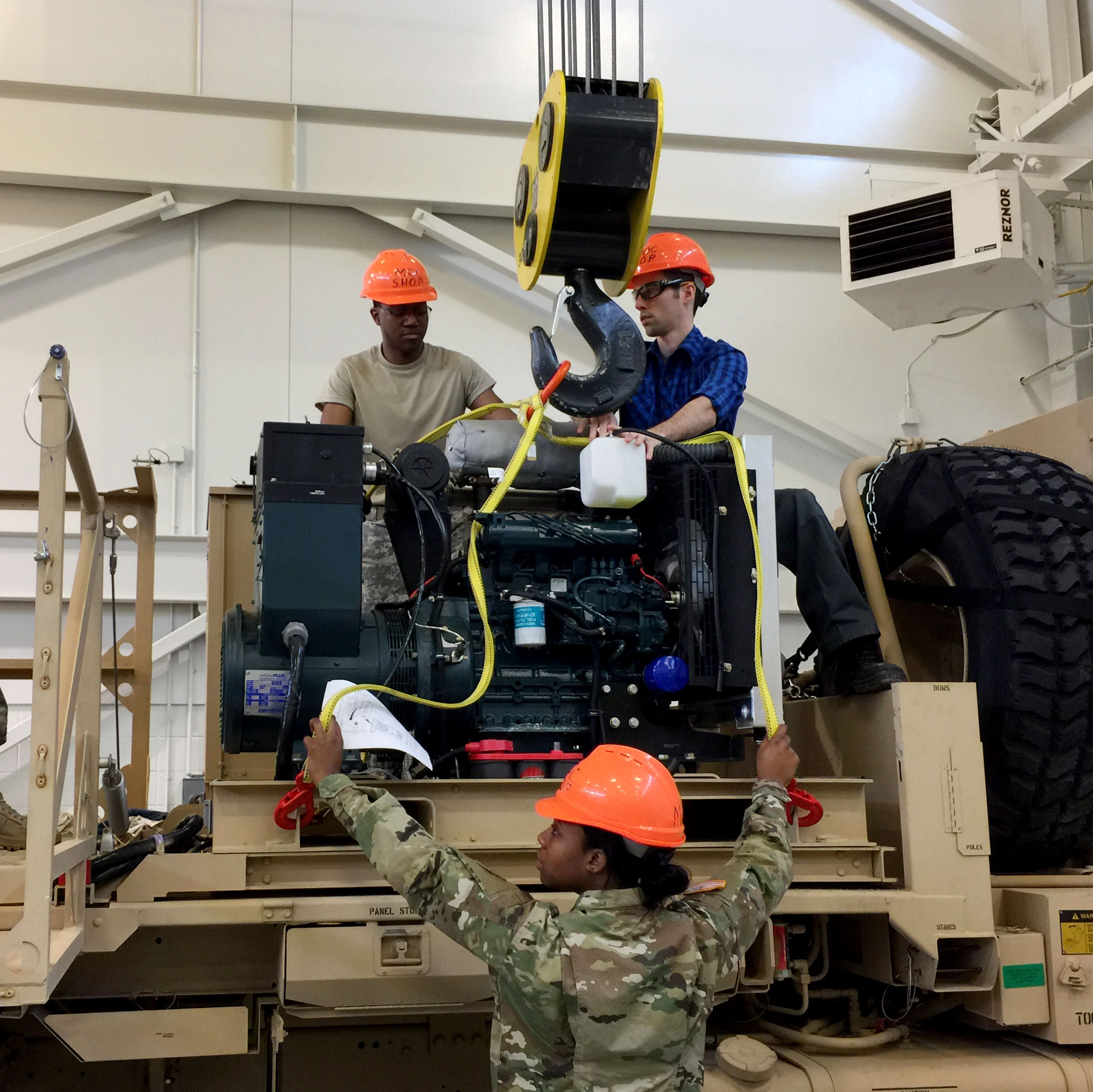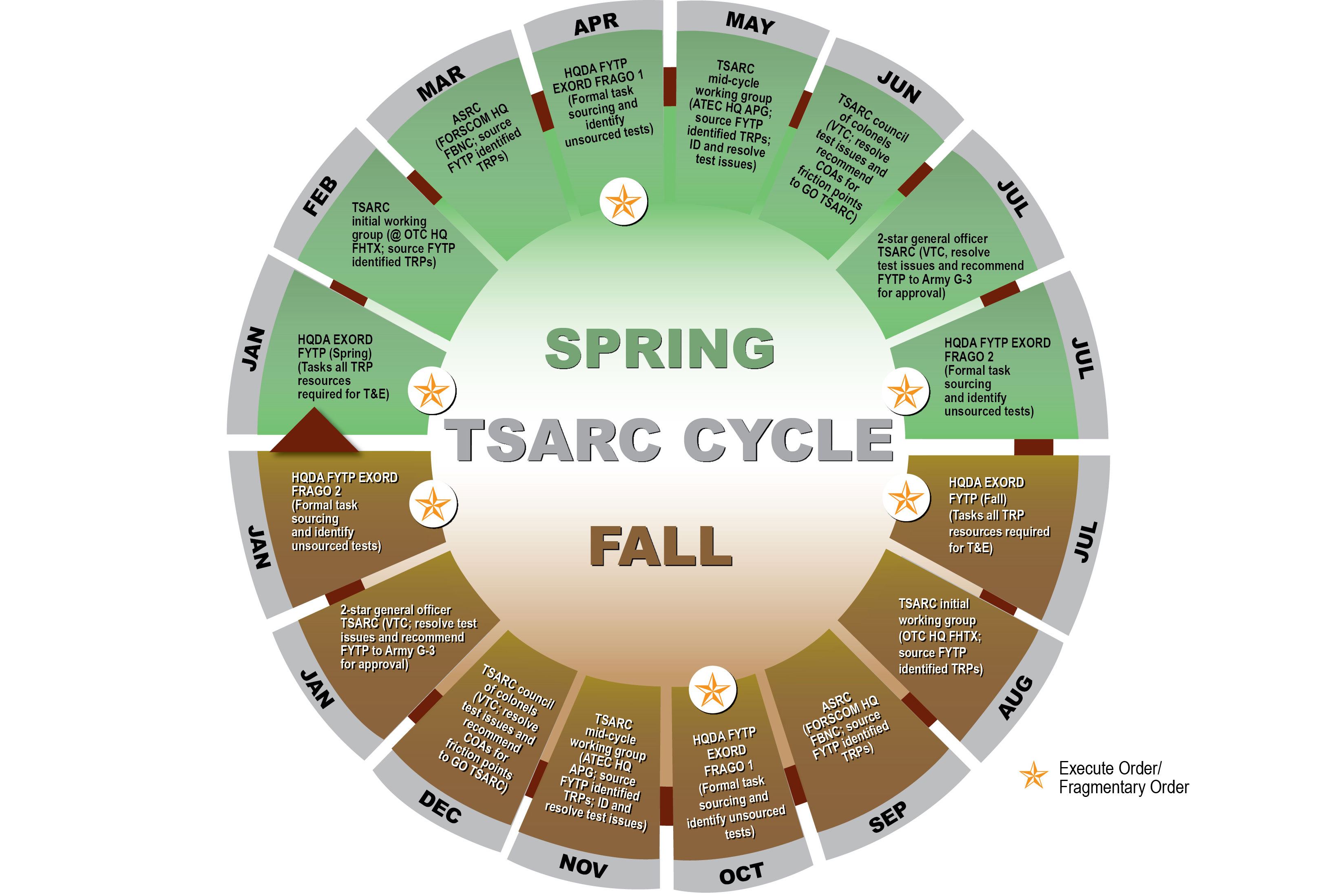
From the standpoint of ASA(ALT)’s test and evaluation unit, there’s a better way to support test and evaluation events, one that would directly improve operational readiness.
by Ms. Laura Pegher, Mr. Adam Bussey and Ms. Amber Dufour
In an acquisition environment concerned with all things cost, schedule and performance, logistics and product testing historically have tended to be an afterthought or overlooked altogether. The Army places a high priority on validating performance requirements in various developmental and operational tests, but acquisition test events such as the logistics demonstration (log demo) and verification of the technical manual often take a back seat.
Based on historical data, the U.S. Army Forces Command (FORSCOM), along with other Army commands, Army service component commands and depot replacement units, have experienced significant challenges with sourcing log demos and technical manual verification events. Sourcing is the term used for applying Soldiers as a test resource. This takes the Soldiers in high-demand military occupational specialties (MOSs), specifically maintainer MOSs, away from their primary duties and deployment training while giving the test community a real-user experience.
Technical manual verification timelines can range from two weeks up to a year, depending on the system complexity, and the average technical manual verification requires five Soldiers as test users. The sourcing challenge is primarily because of the long durations of these events, with negative impacts on unit operational readiness as Soldier maintainers are pulled away to support the event. Given the current state of available resources, test and evaluation (T&E) requirements are exceeding the Army’s capabilities across the force. Thus, the Army must develop solutions to set clear priorities and supply T&E events with adequate resources in order of importance.

Soldiers verify procedures to separate an engine from a generator set at Detroit Arsenal in January. It can take five Soldiers and two to 52 weeks to verify that a technical manual is accurate and usable; proposals to allow log demos and technical manual verifications to occur simultaneously aim to reduce the drain T&E can have on readiness. (Photo by John Lillis, TACOM Life Cycle Management Command)
THE ARMY RESOURCING PROCESS
The Army currently uses a committee called the Test Schedule and Review Committee (TSARC) to manage resources for Army tests, multiservice operational T&E, joint T&E and experiments or demonstrations. The TSARC is responsible for maximizing the use of limited resources while minimizing the test events’ impacts on unit operational readiness. The TSARC’s primary functions include:
- Coordinating all required test resources.
- Synchronizing tests.
- Reviewing schedules.
- Managing support to experiments, investigations, demonstrations, technical manual verifications, studies and other efforts that generally do not require a T&E master plan.
- Validating resource requirements and providing recommendations to the deputy chief of staff, G–3/5/7 for approval or disapproval.
The TSARC process occurs twice in a given fiscal year, with a spring cycle and a fall cycle, and has multiple levels: the initial working group, the mid-cycle working group, the council of colonels and a two-star general officer forum. Each of these groups identifies, coordinates and attempts issue resolution. If needed, the issue is then elevated to the next level. Test resource plans (TRPs), the formal resource document developed by the requesting organization, are submitted to the TSARC for appropriate validation, prioritization and sourcing. All TRPs are cross-checked with all potential force providers to ensure efficient and appropriate use of Army resources.
Participants in the TSARC include the U.S. Army Test and Evaluation Command (ATEC), HQDA G-3/5/7, the assistant secretary of the Army for acquisition, logistics and technology (ASA(ALT)), HQDA G-8, FORSCOM, the U.S. Army Training and Doctrine Command (TRADOC), the deputy undersecretary of the Army for T&E and the U.S. Army Pacific Command.

Maintainers walk through the steps to remove a generator set from a chemical-biological protective shelter at Detroit Arsenal in January. Army regulations require that technical manual verification be conducted completely by Soldiers. However, CASCOM and HQDA G-3/5/7 have made formal requests to ease that requirement and permit government civilian personnel to replace Soldiers. (Photo by John Lillis, TACOM Life Cycle Management Command)
PLAN B: CIVILIANS
Recently, there has been discussion among ATEC, ASA(ALT), HQDA G-3/5/7 and HQDA G-8 on how best to source the log demo and technical manual verification events. Several questions typically arise:
- How long is the event?
- How many Soldiers are required?
- What type (MOS) of Soldier is required for the event?
- What is the impact if the event goes unsourced in this cycle?
- What is the drop-dead date for resources?
- What is the test window for completing this effort?
These discussions have resulted in a better understanding of overall logistics product development, the importance of proving out a weapon system’s product support package before fielding and the difference between a log demo and technical manual verification. TSARC considers the log demo a higher priority event to source with appropriate MOS-qualified Soldiers, given the return on investment for the Army in proving out the maintenance concept and baseline product support strategy.
There are several ongoing initiatives to help reduce resourcing requirements while maintaining an acceptable level of risk for weapon system materiel release decisions, specifically in the area of supportability. The most notable initiative with regard to sourcing is a proposal to change the language of Army Regulation 25-30, Army Publishing Program. AR 25-30 currently requires that technical manual verification be conducted 100 percent hands-on by Soldiers, meaning that every step of the manual is executed by the users. Recently, the U.S. Army Combined Arms Support Command (CASCOM) and HQDA G-3/5/7 have made formal requests to include a requirement of less than 100 percent hands-on technical manual verification and an option to use government civilian personnel in lieu of Soldiers. These proposals were also presented at the June council of colonels TSARC and approved at the June general officers TSARC. These requested changes, if accepted by Office of the Administrative Assistant to the Secretary of the Army, would allow greater flexibility when evaluating the usability and accuracy of technical manuals, and create a more agile publication development process.
The TSARC encourages requesting organizations to continue to pursue Soldiers in support of all test events, including the technical manual verification. However, the TSARC also encourages development of a plan B in the event the TSARC cannot source the event with Soldiers. This is a shift in the technical manual verification culture; once approved, pilot events would begin with the future policy and process updates to follow. This would take six to 12 months to incorporate the proposed policy changes and another year or two to implement fully. Opening up the support resource pool to include civilians presents potential relief to strained Soldier resources. This guidance is in the formal approval process, coordinated among ASA(ALT), ATEC, TRADOC, the U.S. Army Materiel Command, CASCOM and HQDA.

TSARC coordinates a lot of moving pieces, managing resources for Army tests, multiservice operational T&E, joint T&E, and other events. Through working groups, conferences and small- group sessions, TSARC gets the most out of its limited resources while minimizing impacts of testing on unit operational readiness. (Image courtesy of the authors and the U.S. Army Acquisition Support Center)
CONCLUSION
The Army has much work to do to apply these proposed changes, and is well on its way to making other changes to the outdated technical manual processes. A proposal is on the table to implement a three-pronged approach:
- Leverage additional resources (government civilian personnel) to source the technical manual verifications, reducing the demand on Soldiers.
- Use a CASCOM-proposed sampling methodology in lieu of the current 100 percent hands-on approach, effectively reducing timelines for events.
- Combine log demo and technical manual verification events for low-risk Acquisition Category III programs, condensing the resources required and alleviating the demand.
There are several upcoming opportunities in FY18 to pilot the use of government civilians and a proposed sampling methodology. These pilots could be a mechanism to gain insight and feedback on the implementation of a more agile and flexible technical manual development process. The results will be key to supporting the chief of staff of the Army’s No. 1 priority, readiness.
For more information, email the T&E coordination team at usarmy.pentagon.hqda-asa-alt.list.dasm-te@mail.mil.
MS. LAURA PEGHER is the lead T&E coordinator for ASA(ALT). She holds an M.S. in engineering management from George Washington University and a B.S. in electrical engineering from The Pennsylvania State University, and is a licensed professional engineer. She has Army acquisition experience in science and technology and project management, and has coordinated testing for the Army for seven years, including log demo and technical manual verifications. A member of the Army Acquisition Corps (AAC), she is Level III certified in T&E, in engineering and in program management.
MR. ADAM BUSSEY is a T&E coordinator for ASA(ALT). He holds a B.S. in mechanical engineering from The Pennsylvania State University. He has over 10 years of Army test experience and has coordinated large-scale developmental tests for the Army. A member of the AAC, he is Level III certified in T&E and Level I certified in program management and in engineering.
MS. AMBER DUFOUR is a logistics management specialist for the deputy assistant secretary of the Army for acquisition policy and logistics in Arlington, Virginia. She holds an M.A. in management, with a concentration in project management, and a B.S. in mathematics, both from Notre Dame of Maryland University. She has worked in numerous areas of acquisition during more than 10 years of service, including T&E, acquisition logistics, life cycle logistics, project and program management and Army integrated product support policies. A member of the AAC, she is Level III certified in T&E and in life cycle logistics.
ONLINE EXTRAS
“Technical Manuals That Work”: https://asc.army.mil/web/news-alt-jas17-technical-manuals-that-work/.
AR 700-127 Integrated Product Support, October 11, 2016 (Paragraph 11-3): http://www.apd.army.mil/epubs/DR_pubs/DR_a/pdf/web/AR%20700-127_Web_FINAL.pdf.
AR 25-30 Army Publishing Program, June 3, 2015 (Paragraph 3-24, b, 1-2): http://www.apd.army.mil/epubs/DR_pubs/DR_a/pdf/web/r25_30_FINAL.pdf.
AR 73-1 Test and Evaluation Policy, November 16, 2016: http://www.apd.army.mil/epubs/DR_pubs/DR_a/pdf/web/AR73-1_Web_FINAL.pdf.
ATEC Request for Test Services: https://www.atec.army.mil/rfts.html.
This article will be published in the October – December 2017 Army AL&T magazine.
Subscribe to Army AL&T News, the premier online news source for the Acquisition, Logistics, and Technology (AL&T) Workforce.







